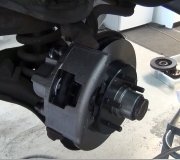Friday, May 18th, 2012 AT 7:01 AM
I just overhauled all four of my my brakes- new wheel cylinders plus hardware for the back, cleaned and rebuilt the front calipers myself. Decided to go with speed bleeders as it makes it a one-man job. I bled everything in order but since I've been driving I notice my car pulls to the left when braking at a decent speed 40-55 mph. I correct it by steering and it goes away and the car rides straight. My brother says adjust the back brakes so I do until I get a decent drag with the drum on. I decide to bleed the front left and get a hose full of tiny bubbles that look like foam until I stop the pedal then they condense into larger air bubbles. I do this until I run out of brake fluid and have to stop (1AM) but decide to check for leaks: piston seal, banjo bolt, the works- everything looks good and the other three wheels bled out fine. And I'll admit- because this turned out to be a good thing- I wasn't exactly watching the master cylinder the whole time and heard that terrible sucking noise that means air just got sucked in. More fluid, pump pump pump, nothing, then the fluid goes through and starts coming out of the hose and, I'll be damned, more of the same air bubbles. What's going on here?



